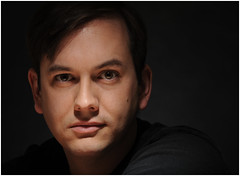 I photographed actor and playwright Cameron McNary as part of my Howard County Arts Council project. Unable to scrounge a decent location, we ended up in the basement -- which meant shooting under 7 1/2-foot ceilings.
I photographed actor and playwright Cameron McNary as part of my Howard County Arts Council project. Unable to scrounge a decent location, we ended up in the basement -- which meant shooting under 7 1/2-foot ceilings.That's always a challenge, as it severely limits lighting angles from overhead. But if you can lower the subject -- as in a seated portrait -- it gives you a little more flexibility.
So we did just that, and played around with a little hard light while we were at it.
__________
Working With a Low Ceiling
Cameron was very cool, and patiently waited as I found a lighting design that would both work for him and fit into our impromptu, height-challenged studio.
Getting him to a lower, seated position allowed me to bring in the key light from a high angle. But even with the subject seated, a high key from a low ceiling height is impossible if the light is very far from the subject. It's just a matter of angles. So we brought it in tight and high and added a grid spot to control spill on the backdrop. (The key was an old WL 600.)
Problem is, being so close the light is going to fall off very quickly. So you are basically just sculpting your leading edges with light at that point.
One solution for the deep shadows left by this kind of key is to use on-axis fill to control the shadow depth. In this case, I used an ABR800 ring flash, set about 2 1/2 stops below the key. (Huh?)
The ring fills the shadows without leaving any telltale shadows of its own -- until you get to the background. Then it screams out, "Hey, lookit me -- I'm a ring flash!"
 An easy fix is to hit the background with its own light. As seen here, it was just a splash -- via an SU-4'd SB-800 coming from back camera left. This kills the ring signature, and also adds a little bit of a lighting layer to the background.
An easy fix is to hit the background with its own light. As seen here, it was just a splash -- via an SU-4'd SB-800 coming from back camera left. This kills the ring signature, and also adds a little bit of a lighting layer to the background.Cameron is a D&D player from way back, and he happened to have his dice with him. (I didn't ask why...) But they added a nice, relevant detail as he is basically rolling the dice with his characters every time he puts pen to paper.
Long-Throw Reflector Key
 For one of the other shots I went back to the 11" sports reflector I had previously used in this test, to work against the edge of the beam.
For one of the other shots I went back to the 11" sports reflector I had previously used in this test, to work against the edge of the beam.I like some of the atypical things you can do with this reflector, but sometimes the fact that it is super efficient can be a bit of a pain. These things throw out a lot of light, so at close range I am usually gonna be using the edge of the beam.
It's kinda sorta like a grid, but not really. It falls off differently, and can sometimes look a little strange. Not that strange is a bad thing -- I am always looking for strange, just in case strange turns out to work well.
In this case, most of the energy from the strobe is missing Cameron and hitting the floor in front of him. This gives a little reflected uplight from the carpet to work against the harsh angle of the top key. To further bring up the shadows I pushed a little ring flash in there, too.
The ring flash is dialed down so low that it doesn't even push any tone back to the dark grey backdrop. To add just enough light to separate his shoulder line, I used a domed SB-800 as a background light directly behind Cameron.
 You can see the extreme angle of the key, here. This is not typical portrait light, but Cameron's work is pretty cerebral and intense. So I figured we could make his headshot a little atypical, too.
You can see the extreme angle of the key, here. This is not typical portrait light, but Cameron's work is pretty cerebral and intense. So I figured we could make his headshot a little atypical, too.Notice his arms are totally blown out. That's okay, because his arms are not going to be in the photo. But it shows you how little of the beam is hitting his face.
This is a cool little trick in that you can have the light coming from the top, and yet the reflected fill from the bottom could actually be brighter than the key on the subject's face. It's all about the angle. And having a deep-dish reflector with such a strongly defined beam on your key helps, too.




0 comments:
Post a Comment